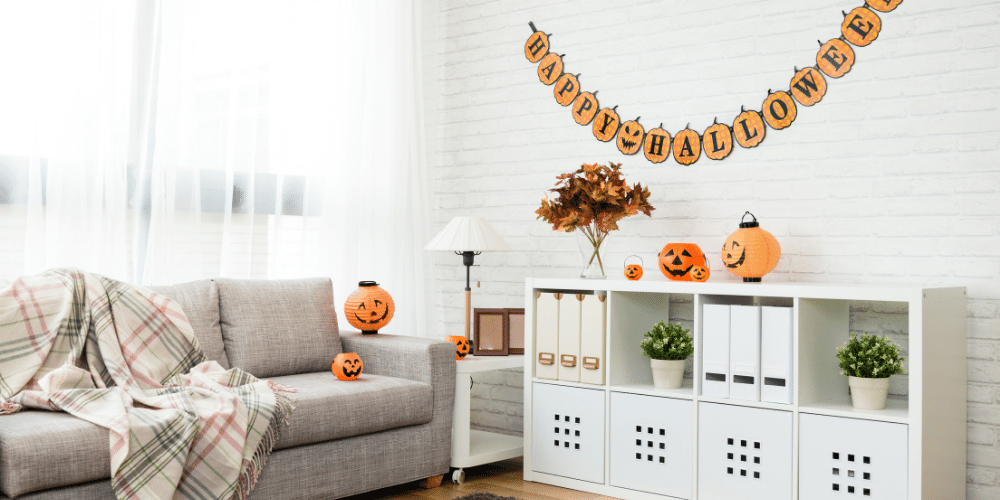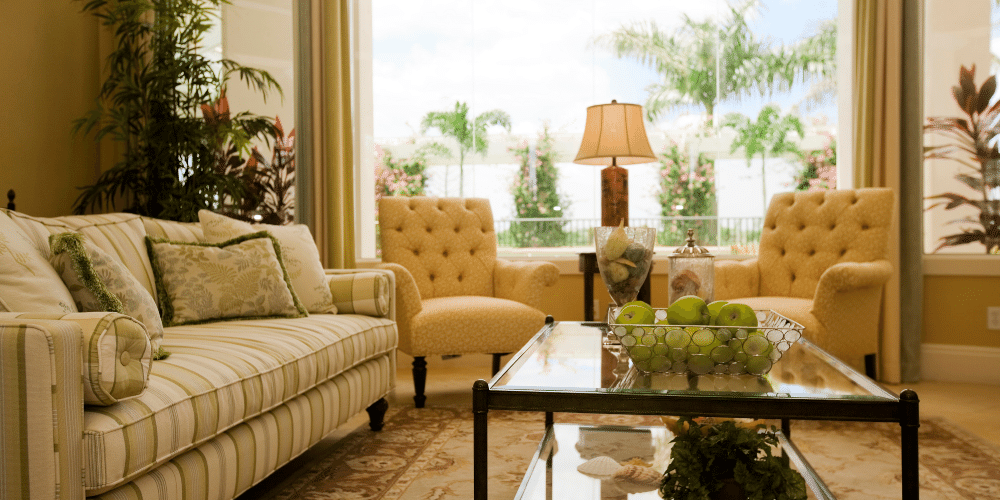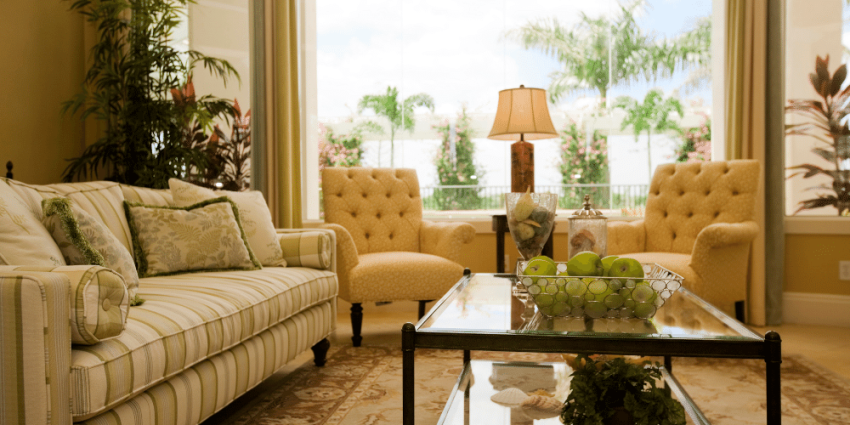One of the best ways to spruce up your living room is by adding some plants. Not only do they add a touch of nature to your space, but they can also help purify the air. If you’re not sure how to arrange plants in your living room, here are a few tips to get you started.
Choose a focal point
When it comes to arranging plants in your living room, it’s important to choose a focal point. This could be a fireplace, a piece of art, or even a window. Once you’ve chosen your focal point, you can then start to arrange your plants around it. Try to create different levels and use varying heights to add interest and depth to your arrangement. And don’t forget the rule of threes – odd numbers always look best!
Consider the light
Light is one of the most important factors to consider when arranging plants in your living room. Plants need light to photosynthesize and grow, so you’ll want to make sure they’re getting enough light. The amount of light your plants need will depend on the species – some plants need full sun, while others can tolerate lower light levels. If you’re not sure how much light a particular plant needs, ask your local nursery or do some research online.
Once you’ve determined how much light your plants need, you can start thinking about where to place them in your living room. If you have a south-facing window, that’s a great spot for full-sun plants. East- and west-facing windows are good for plants that need medium or bright light. North-facing windows usually provide low light, so they’re best suited for plants that can tolerate shady conditions.
When placing your plants, be sure to leave enough space between them for air circulation. Also, keep in mind that some plants (like succulents) like to dry out completely between waterings, while others (like ferns) prefer more frequent watering. Overwatering can lead to root rot, so it’s important to find a balance that works for each individual plant.

Create a sense of balance
When it comes to indoor plants, there are a few things to keep in mind in order to create a sense of balance. First, consider the size of your living room and the amount of natural light it gets. This will help you determine how many plants you can realistically care for.
Next, take into account the overall style of your décor. If you have a lot of other pieces in your living room, you’ll want to be selective about which plants you choose in order to avoid overwhelming the space. Stick to a few key focal points and let the rest of your plant arranging flow from there.
Finally, don’t forget about functionality. Where will you put your plants? Make sure they are out of reach of small children and pets and that they won’t be in the way of foot traffic or other activities in the room. With these things in mind, you can start planning your indoor plant oasis!
Use odd numbers
Odd numbers create more visual interest than even numbers. An odd number of plants will help fill up your living room and make it feel more inviting. Try arranging your plants in threes or fives for the best effect.
Make it personal
To make your living room arrangement personal, start by considering your style and what kind of atmosphere you want to create. If you prefer a more formal look, choose plants with classic shapes like boxwoods or topiaries. For a relaxed vibe, go for hanging plants or cascading vines. Then, think about how much light your living room gets—plants need sunlight to thrive, so pick ones that will do well in the space. Once you’ve narrow down your options, it’s time to get creative! Play around with different plant arrangements until you find one that feels like it fits your home perfectly.
Consider the scale
When deciding on how to arrange plants in your living room, consider the scale of the room and the plants. A large room can accommodate larger plants, while a smaller room may be better suited for smaller plants. Choose plants that will complement the existing furniture and décor in the room. Group plants together based on their size, shape, and color for a cohesive look. Arrange plants in odd numbers for a more balanced look. Use different heights and textures to create interest and depth. And don’t forget about the lighting! Place taller plants near windows and lighter-colored plants in darker corners to brighten up the space.
Use different heights
When it comes to plants, don’t be afraid to mix things up in terms of height. Short plants can go on shelves or tabletops, while taller ones can go on the floor.
If you have a lot of shelving, consider using some of it for plants. This will add some green to your décor and break up all of the other items on the shelves.
Don’t be afraid to put taller plants in the corner of a room. This can add some much-needed height and visual interest to a space.
And, of course, don’t forget about hanging plants! These are perfect for adding a touch of greenery without taking up too much space.
Repetition creates harmony
Repetition creates harmony in your living room by using the same type of plant or the same color plant throughout the space. This will give your living room a sense of cohesion and peace. To achieve this, start with one type of plant or one color plant and work your way around the room, adding more of the same plants as you go. Try to group plants together in odd numbers for a more pleasing effect. And don’t forget to leave some negative space in your living room for balance.
Group plants with similar needs
When it comes to arranging plants in your living room, one of the most important things to keep in mind is grouping plants with similar needs together. This will make it easier for you to provide each plant with the care it needs, and will also help to create a more visually appealing arrangement.
Some of the things you’ll need to consider when grouping plants include:
– Light requirements: Make sure to group plants together that have similar light requirements. This will ensure that each plant gets the right amount of light and doesn’t end up struggling.
– Water needs: Grouping plants with similar water needs is also important. This way, you can make sure that each plant is getting the right amount of water and not too much or too little.
– Soil type: Another thing to consider when grouping plants is the type of soil they need. Some plants prefer sandy soil while others do better in clay soil. If you group plants together with different soil preferences, it’s likely that at least one of them will end up unhappy.
By taking these factors into consideration, you can create a beautiful and functional living room arrangement that will make both you and your plants happy!
Add something living
When it comes to arranging plants in living room, there are a few things you need to take into account. First, you need to decide on the type of plants you want to use. There are many different types of plants that can be used in living room arrangements, so take some time to browse through catalogs or visit your local nursery to get an idea of what is available. Once you have decided on the types of plants you want to use, you need to consider the placement of the plants. You need to make sure that the plants will get enough light and that they will not be too close to any heat sources. You also want to make sure that the plants are not going to be in the way of any furniture or walkways. Once you have taken all of these factors into consideration, you can start arranging your plants. Start by placing the largest plant in the center of the arrangement and then work your way out from there. Be sure to leave some space between each plant so that they have room to grow.
Why you need plants in your living room
There are plenty of reasons to keep plants in your living room. Not only do they look great, but they can also purify the air and improve your health. Here are just a few reasons why you should consider adding some plants to your living room:
1. Plants Purify the Air
One of the most important benefits of plants is that they help purify the air. They do this by absorbing carbon dioxide and releasing oxygen back into the atmosphere. This can help improve your indoor air quality and reduce your risk of respiratory problems.
2. Plants Boost Your Mood
Another great reason to keep plants in your living room is that they can boost your mood. Studies have shown that being around plants can lower stress levels and increase feelings of happiness and well-being. So if you’re looking for a way to relax and de-stress, adding some plants to your living room is a great option.
3. Plants Improve Your Health
Not only do plants purify the air and boost your mood, but they can also improve your overall health. Plants can help reduce fatigue, headaches, and sore throats. They can also improve concentration and memory function. So if you want to live a healthier life, keeping plants in your living room is a good idea.
The benefits of plants
When it comes to benefits, plants are often thought of in relation to their role in the natural world – they help purify the air, provide oxygen and improve our moods. But there are plenty of benefits to be enjoyed even if you don’t have a green thumb. Here are some of the ways plants can enhance your life:
Plants can boost your mood and mental health
Numerous studies have shown that plants can have a positive effect on our mental health. One study showed that hospital patients who had potted plants in their room recovered from surgery faster than those who didn’t. Plants have also been shown to reduce stress levels, anxiety and depression. And if that’s not enough, they can also improve memory and concentration.
Plants can improve your physical health
Not only can plants improve your mental health, but they can also do wonders for your physical health. Plants help purify the air, which is especially beneficial if you live in an urban area with high levels of pollution. They also help reduce noise levels and increase humidity, both of which are great for your skin (and your sinuses!). Plants have even been shown to boost immunity and fight off colds and other illnesses.
Plants make your home more beautiful
Of course, one of the main reasons people choose to keep plants in their homes is because they simply make the space more pleasant and attractive. A few well-placed plants can transform a room, adding color, texture and life. And if you’re not sure where to start, there are plenty of resources available to help you choose the right plants for your home.
Plants can save you money
While some plants can be quite expensive, others are very affordable – and many can even save you money in the long run. For example, plants that purify the air can help reduce your energy bills by making your home more comfortable (and therefore requiring less air conditioning or heating). And if you choose low-maintenance plants that don’t require a lot of water or care, you’ll save even more money in the long run.
How to choose the right plants for your living room
When choosing plants for your living room, there are a few things to keep in mind. First, think about the light in the room. If you have a lot of natural light, you can choose plants that require more sun. If you have low light, look for plants that can thrive in shady areas. Second, consider the size of your space and the size of the plants you want to add. Make sure the plants you choose will fit comfortably in your room without crowding it. Finally, think about your own personal style and what type of plants will complement your décor. Once you have an idea of what you’re looking for, head to your local nursery or garden center and start picking out your new living room additions!

Where to put your plants in the living room
When it comes to determining where to put your plants in the living room, there are a few things you’ll want to take into consideration. First, think about the amount of sunlight that each spot in the room gets throughout the day. You’ll want to choose a location for your plants that will give them the amount of light they need to thrive. Secondly, consider the temperature of different areas in the room. Some plants prefer warmer temperatures while others do better in cooler environments. Find a place for your plants that will meet their temperature needs. Lastly, take into account the overall aesthetic you’re going for in the room. Grouping similar plants together can create a cohesive look, or you can mix and match different types of plants to create an eclectic feel. No matter what style you’re going for, there’s a way to incorporate plants into your living room design.
How to care for your plants
When it comes to caring for your plants, there are a few key things to keep in mind. First, be sure to provide them with enough light. Most plants need at least six hours of sunlight per day, so if you don’t have a lot of natural light in your home, you may need to supplement with artificial lighting.
Second, make sure you’re giving them the right amount of water. Over-watering is one of the most common mistakes people make when it comes to plant care, so err on the side of caution and don’t water too often. Allow the soil to dry out between watering sessions, and if possible, use a moisture meter to check the soil before watering.
Finally, don’t forget about fertilizing your plants! Just like people, plants need nutrients to stay healthy and thrive. Use a fertilizer specifically designed for plants (available at any garden center) and follow the directions on the package for best results.
Conclusion
There are many ways to arrange plants in a living room, and it ultimately depends on the size and layout of the room as well as your personal preferences. Some people like to keep their plants close together, while others prefer to spread them out throughout the room. There are also different ways to group plants together, such as by type or by color. Experiment with different arrangements until you find one that you love!










Leave a Reply